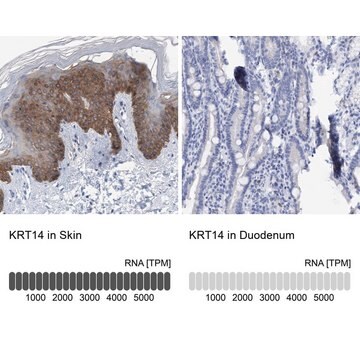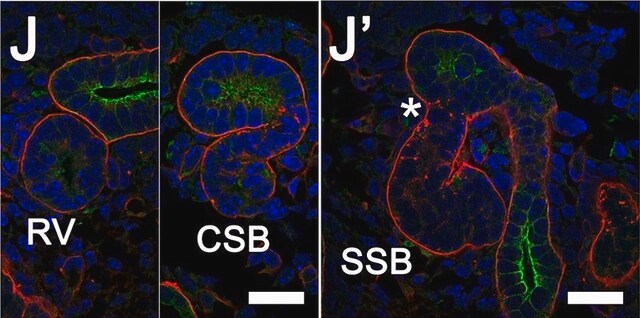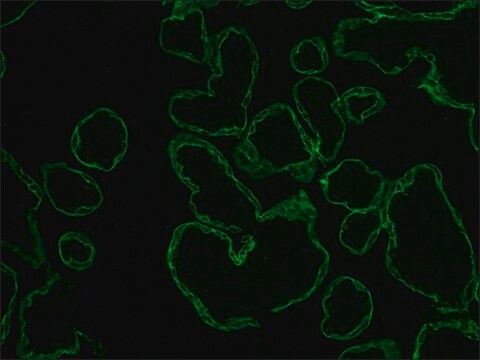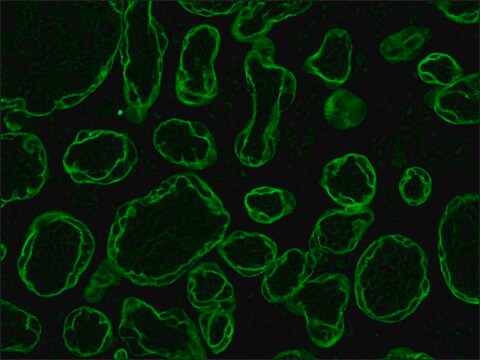推薦產品
生物源
mouse
品質等級
共軛
unconjugated
抗體表格
ascites fluid
抗體產品種類
primary antibodies
無性繁殖
CKB1, monoclonal
包含
15 mM sodium azide
物種活性
human
技術
immunohistochemistry (formalin-fixed, paraffin-embedded sections): suitable
immunohistochemistry (frozen sections): suitable
indirect immunofluorescence: 1:200 using methacarn-fixed, paraffin-embedded human tissue sections
同型
IgM
UniProt登錄號
運輸包裝
dry ice
儲存溫度
−20°C
目標翻譯後修改
unmodified
基因資訊
human ... KRT14(3861)
一般說明
Monoclonal Anti-Cytokeratin Peptide 14 (mouse IgM isotype) is derived from the hybridoma produced by the fusion of mouse myeloma cells and splenocytes from an immunized mouse. Keratin 14 (KRT14) is expressed in keratinocytes and localized to the basal epidermal layer. The gene is mapped to human chromosome 17q21 and encodes an intermediate filament.
特異性
The antibody reacts with myoepithelial cells in various organs (parotid, submandibular, mammary, prostate, and sweat glands) as well as with the basal layer of certain squamous epithelium (exocervical, laryngeal epithelium).
免疫原
human callus keratins.
應用
Monoclonal Anti-Cytokeratin Peptide 14 antibody produced in mouse has been used in indirect immunofluorescence or immunoperoxidase techniques.
生化/生理作用
Keratin 14 (KRT14) is associated with maintaining cellular stability. Mutation in the KRT14 gene leads to epidermolysis bullosa simplex, a genetic disorder. It is known to promote angiogenesis, cell migration and proliferation in cancer cells.
免責聲明
Unless otherwise stated in our catalog or other company documentation accompanying the product(s), our products are intended for research use only and are not to be used for any other purpose, which includes but is not limited to, unauthorized commercial uses, in vitro diagnostic uses, ex vivo or in vivo therapeutic uses or any type of consumption or application to humans or animals.
未找到適合的產品?
試用我們的產品選擇工具.
儲存類別代碼
10 - Combustible liquids
水污染物質分類(WGK)
nwg
閃點(°F)
Not applicable
閃點(°C)
Not applicable
PADI4 has genetic susceptibility to gastric carcinoma and upregulates CXCR2, KRT14 and TNF-alpha expression levels
Zheng Y, et al.
Oncotarget, 7(38), 62159-62159 (2016)
Amina Errazahi et al.
Journal of bone and mineral research : the official journal of the American Society for Bone and Mineral Research, 18(4), 737-750 (2003-04-04)
The presence of identical or distinct type I parathyroid hormone (PTH)/parathyroid hormone-related peptide (PTHrP) receptors in keratinocytes is still a matter of debate. We studied the expression and functionality of PTHrP receptors in freshly isolated keratinocytes from newborn rat skin.
Cut and Paste: Efficient Homology-Directed Repair of a Dominant Negative KRT14 Mutation via CRISPR/Cas9 Nickases
Kocher, et al.
Molecular Therapy, 25(11), 2585-2585 (2017)
J Caselitz et al.
Virchows Archiv. A, Pathological anatomy and histopathology, 409(5), 725-738 (1986-01-01)
Myoepithelial and luminal cells of human exocrine glands can be positively identified with two different monoclonal antibodies. Myoepithelial cells including those of the salivary gland, mammary gland and sweat gland are positively identified by an antibody CKB1. This antibody does
Y Gache et al.
The Journal of clinical investigation, 97(10), 2289-2298 (1996-05-15)
Epidermolysis bullosa simplex with muscular dystrophy (MD-EBS) is a disease characterized by generalized blistering of the skin associated with muscular involvement. We report that the skin of three MD-EBS patients is not reactive with antibodies 6C6, 10F6, or 5B3 raised
我們的科學家團隊在所有研究領域都有豐富的經驗,包括生命科學、材料科學、化學合成、色譜、分析等.
聯絡技術服務








